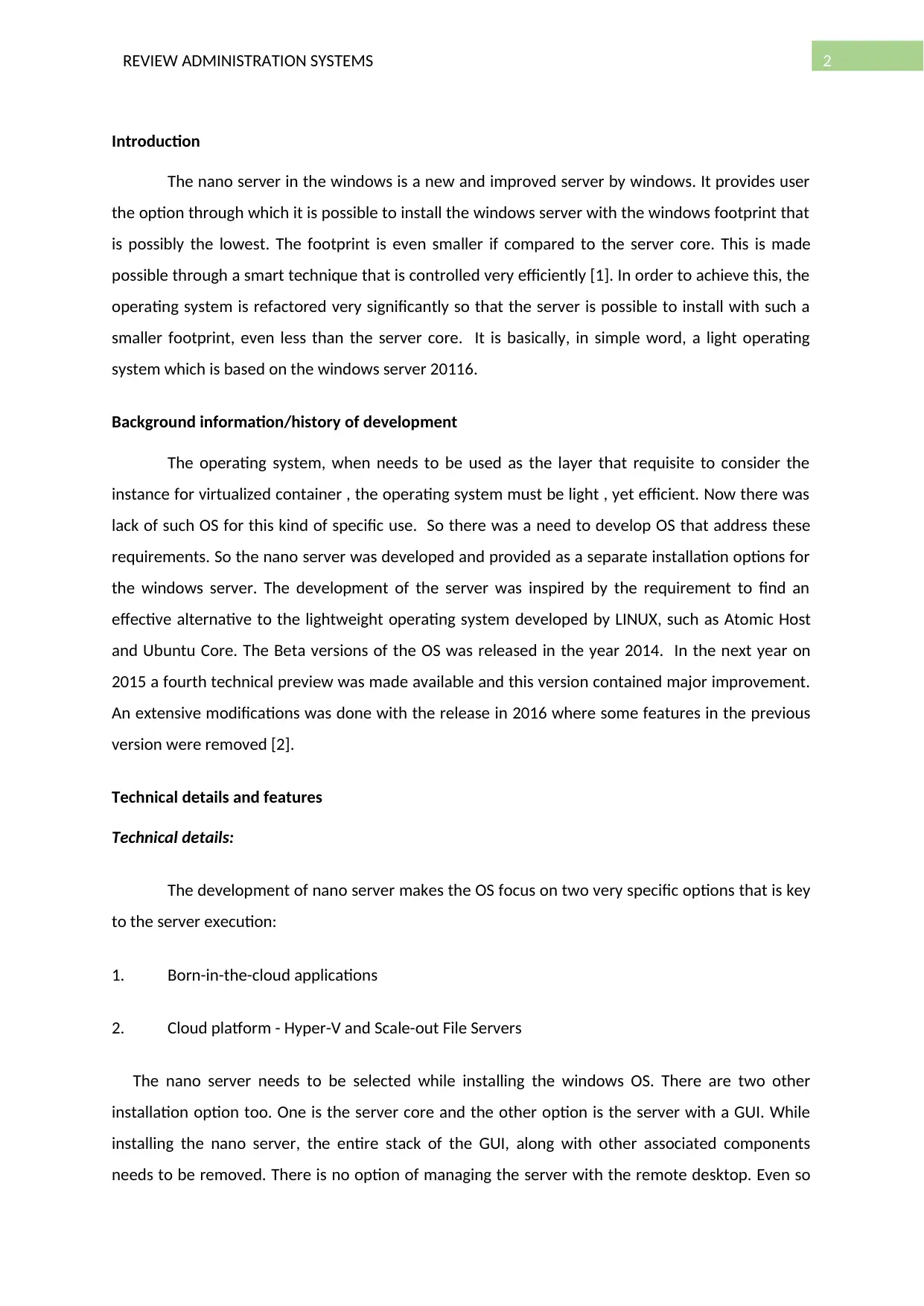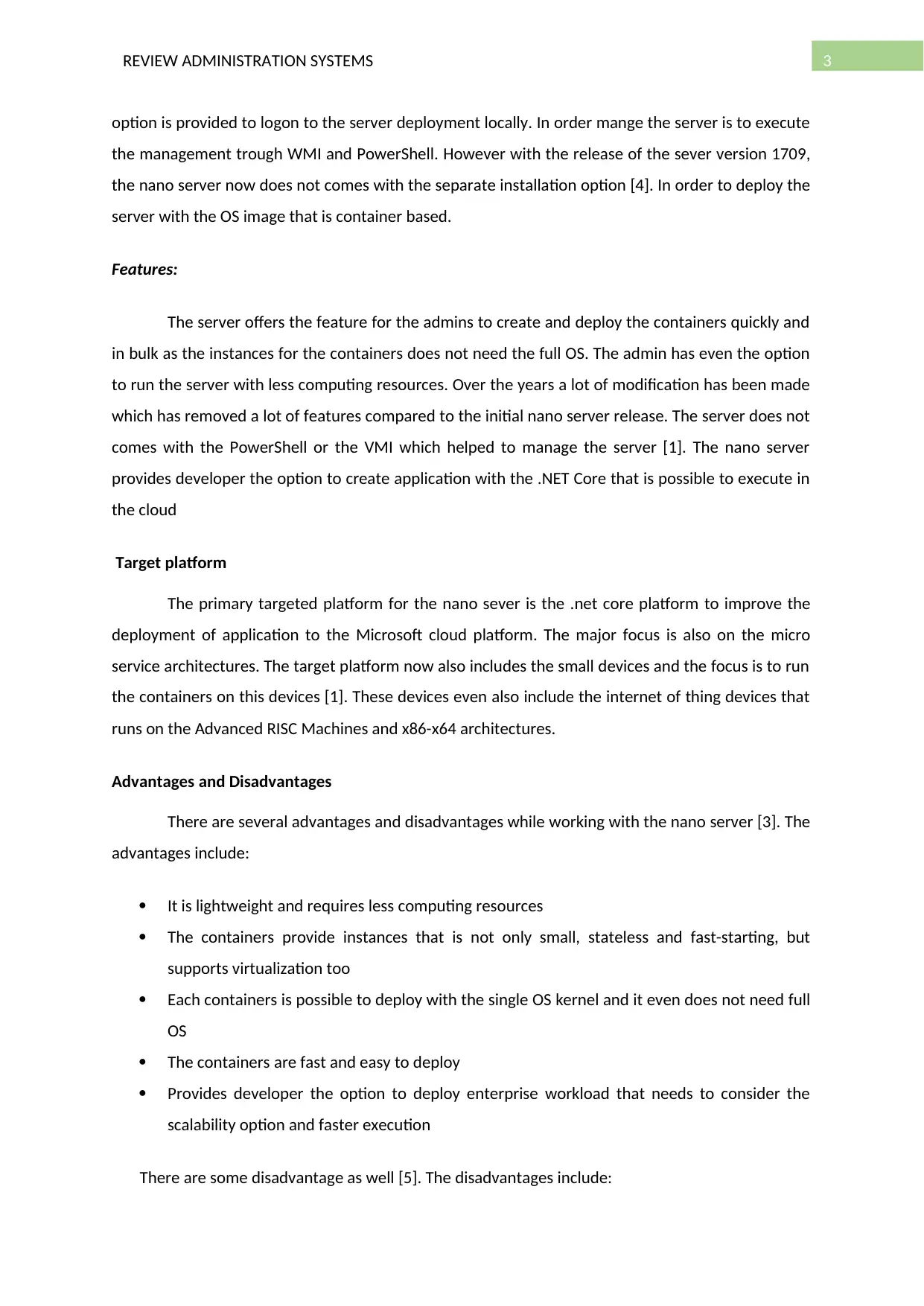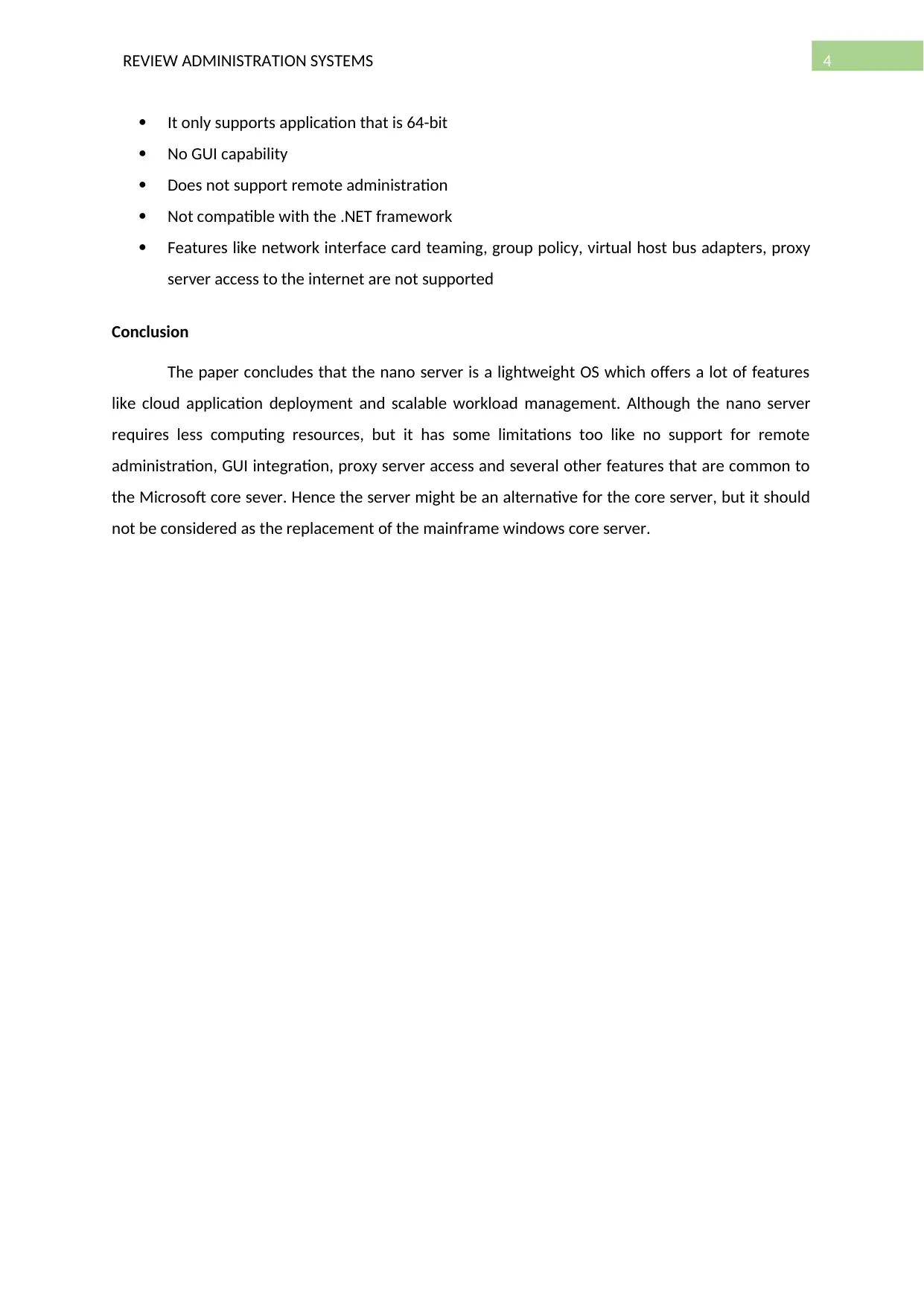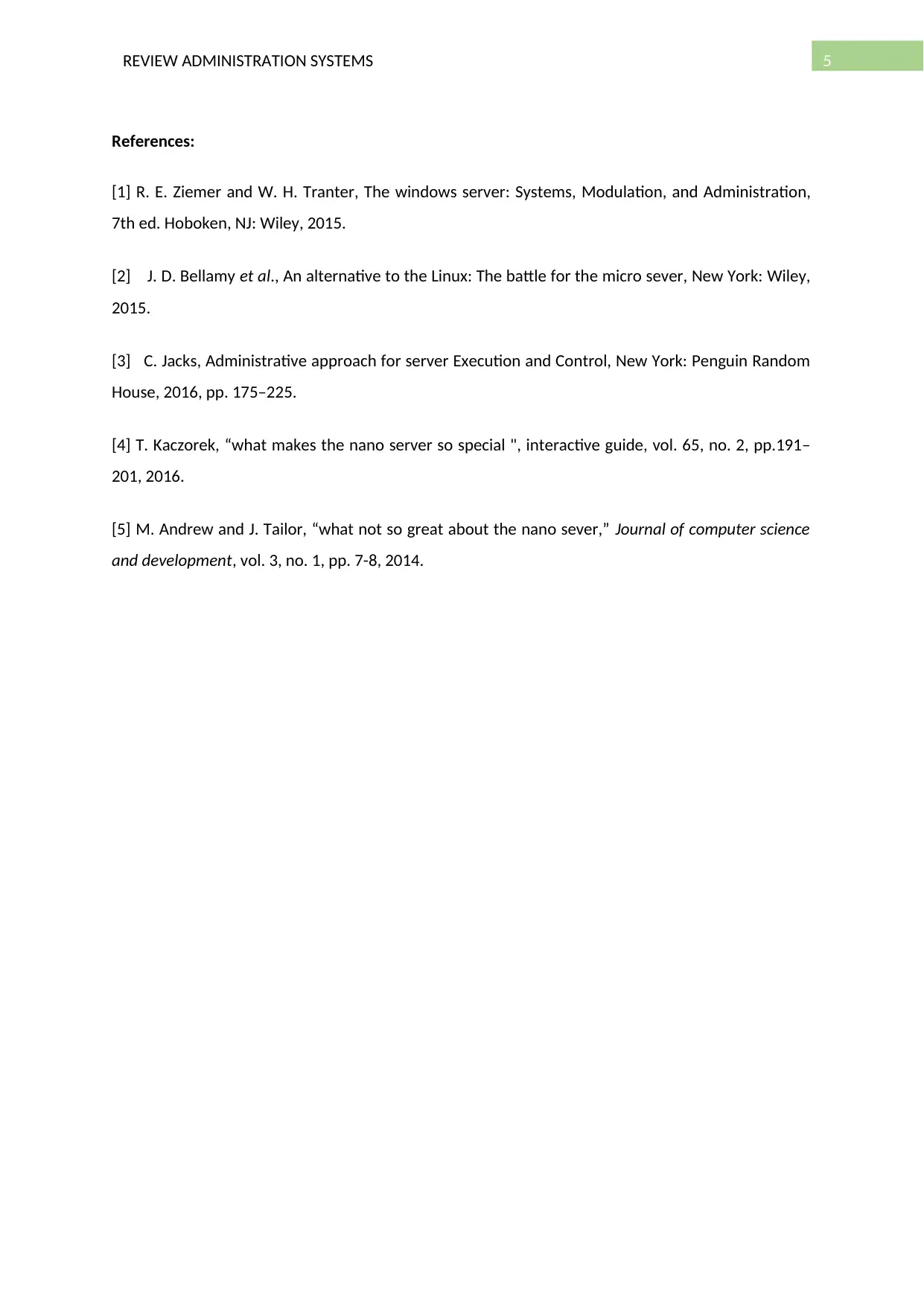BN206 System Administration: Server Management Systems & Tools (T2)
VerifiedAdded on 2023/06/07
|6
|1174
|274
Report
AI Summary
This report provides an overview of server management systems, focusing on the Windows Nano Server. It details the background, technical features, target platforms, advantages, and disadvantages of Nano Server, highlighting its role in cloud application deployment and scalable workload management. The report also acknowledges the limitations of Nano Server, such as the lack of remote administration and GUI integration, suggesting that while it offers benefits, it should not be considered a complete replacement for the traditional Windows core server. Desklib offers a wide range of study resources, including past papers and solved assignments, to support students in their academic endeavors.

Running head: REVIEW ADMINISTRATION SYSTEMS
REVIEW ADMINISTRATION SYSTEMS
Name of the Student
Name of the University
Author note
REVIEW ADMINISTRATION SYSTEMS
Name of the Student
Name of the University
Author note
Paraphrase This Document
Need a fresh take? Get an instant paraphrase of this document with our AI Paraphraser

1REVIEW ADMINISTRATION SYSTEMS
Table of Contents
Introduction...........................................................................................................................................2
Background information/history of development.................................................................................2
Technical details and features...............................................................................................................2
Target platform......................................................................................................................................3
Advantages and Disadvantages.............................................................................................................3
Conclusion.............................................................................................................................................4
References:............................................................................................................................................5
Table of Contents
Introduction...........................................................................................................................................2
Background information/history of development.................................................................................2
Technical details and features...............................................................................................................2
Target platform......................................................................................................................................3
Advantages and Disadvantages.............................................................................................................3
Conclusion.............................................................................................................................................4
References:............................................................................................................................................5

2REVIEW ADMINISTRATION SYSTEMS
Introduction
The nano server in the windows is a new and improved server by windows. It provides user
the option through which it is possible to install the windows server with the windows footprint that
is possibly the lowest. The footprint is even smaller if compared to the server core. This is made
possible through a smart technique that is controlled very efficiently [1]. In order to achieve this, the
operating system is refactored very significantly so that the server is possible to install with such a
smaller footprint, even less than the server core. It is basically, in simple word, a light operating
system which is based on the windows server 20116.
Background information/history of development
The operating system, when needs to be used as the layer that requisite to consider the
instance for virtualized container , the operating system must be light , yet efficient. Now there was
lack of such OS for this kind of specific use. So there was a need to develop OS that address these
requirements. So the nano server was developed and provided as a separate installation options for
the windows server. The development of the server was inspired by the requirement to find an
effective alternative to the lightweight operating system developed by LINUX, such as Atomic Host
and Ubuntu Core. The Beta versions of the OS was released in the year 2014. In the next year on
2015 a fourth technical preview was made available and this version contained major improvement.
An extensive modifications was done with the release in 2016 where some features in the previous
version were removed [2].
Technical details and features
Technical details:
The development of nano server makes the OS focus on two very specific options that is key
to the server execution:
1. Born-in-the-cloud applications
2. Cloud platform - Hyper-V and Scale-out File Servers
The nano server needs to be selected while installing the windows OS. There are two other
installation option too. One is the server core and the other option is the server with a GUI. While
installing the nano server, the entire stack of the GUI, along with other associated components
needs to be removed. There is no option of managing the server with the remote desktop. Even so
Introduction
The nano server in the windows is a new and improved server by windows. It provides user
the option through which it is possible to install the windows server with the windows footprint that
is possibly the lowest. The footprint is even smaller if compared to the server core. This is made
possible through a smart technique that is controlled very efficiently [1]. In order to achieve this, the
operating system is refactored very significantly so that the server is possible to install with such a
smaller footprint, even less than the server core. It is basically, in simple word, a light operating
system which is based on the windows server 20116.
Background information/history of development
The operating system, when needs to be used as the layer that requisite to consider the
instance for virtualized container , the operating system must be light , yet efficient. Now there was
lack of such OS for this kind of specific use. So there was a need to develop OS that address these
requirements. So the nano server was developed and provided as a separate installation options for
the windows server. The development of the server was inspired by the requirement to find an
effective alternative to the lightweight operating system developed by LINUX, such as Atomic Host
and Ubuntu Core. The Beta versions of the OS was released in the year 2014. In the next year on
2015 a fourth technical preview was made available and this version contained major improvement.
An extensive modifications was done with the release in 2016 where some features in the previous
version were removed [2].
Technical details and features
Technical details:
The development of nano server makes the OS focus on two very specific options that is key
to the server execution:
1. Born-in-the-cloud applications
2. Cloud platform - Hyper-V and Scale-out File Servers
The nano server needs to be selected while installing the windows OS. There are two other
installation option too. One is the server core and the other option is the server with a GUI. While
installing the nano server, the entire stack of the GUI, along with other associated components
needs to be removed. There is no option of managing the server with the remote desktop. Even so
⊘ This is a preview!⊘
Do you want full access?
Subscribe today to unlock all pages.

Trusted by 1+ million students worldwide

3REVIEW ADMINISTRATION SYSTEMS
option is provided to logon to the server deployment locally. In order mange the server is to execute
the management trough WMI and PowerShell. However with the release of the sever version 1709,
the nano server now does not comes with the separate installation option [4]. In order to deploy the
server with the OS image that is container based.
Features:
The server offers the feature for the admins to create and deploy the containers quickly and
in bulk as the instances for the containers does not need the full OS. The admin has even the option
to run the server with less computing resources. Over the years a lot of modification has been made
which has removed a lot of features compared to the initial nano server release. The server does not
comes with the PowerShell or the VMI which helped to manage the server [1]. The nano server
provides developer the option to create application with the .NET Core that is possible to execute in
the cloud
Target platform
The primary targeted platform for the nano sever is the .net core platform to improve the
deployment of application to the Microsoft cloud platform. The major focus is also on the micro
service architectures. The target platform now also includes the small devices and the focus is to run
the containers on this devices [1]. These devices even also include the internet of thing devices that
runs on the Advanced RISC Machines and x86-x64 architectures.
Advantages and Disadvantages
There are several advantages and disadvantages while working with the nano server [3]. The
advantages include:
It is lightweight and requires less computing resources
The containers provide instances that is not only small, stateless and fast-starting, but
supports virtualization too
Each containers is possible to deploy with the single OS kernel and it even does not need full
OS
The containers are fast and easy to deploy
Provides developer the option to deploy enterprise workload that needs to consider the
scalability option and faster execution
There are some disadvantage as well [5]. The disadvantages include:
option is provided to logon to the server deployment locally. In order mange the server is to execute
the management trough WMI and PowerShell. However with the release of the sever version 1709,
the nano server now does not comes with the separate installation option [4]. In order to deploy the
server with the OS image that is container based.
Features:
The server offers the feature for the admins to create and deploy the containers quickly and
in bulk as the instances for the containers does not need the full OS. The admin has even the option
to run the server with less computing resources. Over the years a lot of modification has been made
which has removed a lot of features compared to the initial nano server release. The server does not
comes with the PowerShell or the VMI which helped to manage the server [1]. The nano server
provides developer the option to create application with the .NET Core that is possible to execute in
the cloud
Target platform
The primary targeted platform for the nano sever is the .net core platform to improve the
deployment of application to the Microsoft cloud platform. The major focus is also on the micro
service architectures. The target platform now also includes the small devices and the focus is to run
the containers on this devices [1]. These devices even also include the internet of thing devices that
runs on the Advanced RISC Machines and x86-x64 architectures.
Advantages and Disadvantages
There are several advantages and disadvantages while working with the nano server [3]. The
advantages include:
It is lightweight and requires less computing resources
The containers provide instances that is not only small, stateless and fast-starting, but
supports virtualization too
Each containers is possible to deploy with the single OS kernel and it even does not need full
OS
The containers are fast and easy to deploy
Provides developer the option to deploy enterprise workload that needs to consider the
scalability option and faster execution
There are some disadvantage as well [5]. The disadvantages include:
Paraphrase This Document
Need a fresh take? Get an instant paraphrase of this document with our AI Paraphraser

4REVIEW ADMINISTRATION SYSTEMS
It only supports application that is 64-bit
No GUI capability
Does not support remote administration
Not compatible with the .NET framework
Features like network interface card teaming, group policy, virtual host bus adapters, proxy
server access to the internet are not supported
Conclusion
The paper concludes that the nano server is a lightweight OS which offers a lot of features
like cloud application deployment and scalable workload management. Although the nano server
requires less computing resources, but it has some limitations too like no support for remote
administration, GUI integration, proxy server access and several other features that are common to
the Microsoft core sever. Hence the server might be an alternative for the core server, but it should
not be considered as the replacement of the mainframe windows core server.
It only supports application that is 64-bit
No GUI capability
Does not support remote administration
Not compatible with the .NET framework
Features like network interface card teaming, group policy, virtual host bus adapters, proxy
server access to the internet are not supported
Conclusion
The paper concludes that the nano server is a lightweight OS which offers a lot of features
like cloud application deployment and scalable workload management. Although the nano server
requires less computing resources, but it has some limitations too like no support for remote
administration, GUI integration, proxy server access and several other features that are common to
the Microsoft core sever. Hence the server might be an alternative for the core server, but it should
not be considered as the replacement of the mainframe windows core server.

5REVIEW ADMINISTRATION SYSTEMS
References:
[1] R. E. Ziemer and W. H. Tranter, The windows server: Systems, Modulation, and Administration,
7th ed. Hoboken, NJ: Wiley, 2015.
[2] J. D. Bellamy et al., An alternative to the Linux: The battle for the micro sever, New York: Wiley,
2015.
[3] C. Jacks, Administrative approach for server Execution and Control, New York: Penguin Random
House, 2016, pp. 175–225.
[4] T. Kaczorek, “what makes the nano server so special ", interactive guide, vol. 65, no. 2, pp.191–
201, 2016.
[5] M. Andrew and J. Tailor, “what not so great about the nano sever,” Journal of computer science
and development, vol. 3, no. 1, pp. 7-8, 2014.
References:
[1] R. E. Ziemer and W. H. Tranter, The windows server: Systems, Modulation, and Administration,
7th ed. Hoboken, NJ: Wiley, 2015.
[2] J. D. Bellamy et al., An alternative to the Linux: The battle for the micro sever, New York: Wiley,
2015.
[3] C. Jacks, Administrative approach for server Execution and Control, New York: Penguin Random
House, 2016, pp. 175–225.
[4] T. Kaczorek, “what makes the nano server so special ", interactive guide, vol. 65, no. 2, pp.191–
201, 2016.
[5] M. Andrew and J. Tailor, “what not so great about the nano sever,” Journal of computer science
and development, vol. 3, no. 1, pp. 7-8, 2014.
⊘ This is a preview!⊘
Do you want full access?
Subscribe today to unlock all pages.

Trusted by 1+ million students worldwide
1 out of 6
Related Documents
Your All-in-One AI-Powered Toolkit for Academic Success.
+13062052269
info@desklib.com
Available 24*7 on WhatsApp / Email
![[object Object]](/_next/static/media/star-bottom.7253800d.svg)
Unlock your academic potential
Copyright © 2020–2025 A2Z Services. All Rights Reserved. Developed and managed by ZUCOL.



